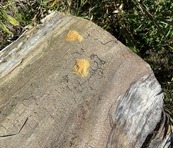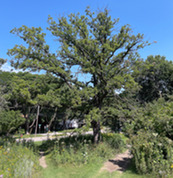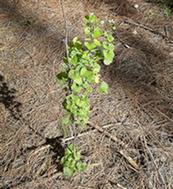|
Images may appear blurry in some web browsers. We recommend opening newsletter links in Google Chrome.

Oak wilt, a deadly disease of oaks, has been found for the first time in Ashland County.
The Wisconsin Department of Natural Resources (DNR) confirmed the find in wood samples from a red oak tree in the town of Gordon.
Oak wilt is commonly found in the southern two-thirds of the state and is creeping north. It has been identified in 66 of Wisconsin’s 72 counties.
|

The Wisconsin Department of Natural Resources (DNR) cautions hunters to avoid placing deer stands in or near ash trees this deer hunting season.
Most ash trees in the southern half of Wisconsin, Door County and the Mississippi River counties are dead or dying from emerald ash borer infestation.
Although emerald ash borer is not as widespread in other parts of the state, the invasive insect continues to be found at additional locations throughout the state and unreported infestations also are likely.
|

October was National Firewood Awareness Month, and even though November has arrived, the Wisconsin Department of Natural Resources continues to urge residents and visitors to avoid moving firewood.
That’s because tree-killing hitchhikers often lurk on or in firewood — including spongy moth, emerald ash borer, the fungus that causes oak wilt and other invasive insects and fungi. When untreated, infested firewood is transported away from where the tree died, those pests and fungi can later emerge to attack trees at the new site.
|

White, red and bur oaks have been experiencing increased mortality in Wisconsin and neighboring states over the last few years.
The causes of mortality are varied, but two-lined chestnut borer (TLCB) is the most common culprit. Wisconsin has switched from a period of historically wet years (2017-2020) to drought conditions that have become more severe each year (2021-2023).
|

Typically a biennial plant, garlic mustard blooms in the spring. So, it sounds crazy to find the plant blooming again in October.
Although garlic mustard might be taking advantage of an extended growing season, this second bloom also may be cause for concern — or, at least, careful monitoring.
Wisconsin Department of Natural Resources Tax Law Forestry Specialist Frederick Hengst discovered this “mutant” specimen in early October while on a landowner visit near Wild Rose. The plant appears to have flowered and set seed several months earlier, but then re-flowered on the same stem.
|

Entomology Today magazine has published an article debunking common misconceptions about management of emerald ash borer (EAB). The information can be helpful to those deciding whether to invest in treatment to preserve ash trees.
The article focuses on treatments for high-value trees, not those in woodlands. The advice is clear for communities, property managers of high-use recreational lands and homeowners with ash near residences: “Allowing nature to take its course is a budget-busting option.”
|

As if black ash trees don’t have enough problems with emerald ash borer (EAB), another ash pest recently was found at several locations in northern Wisconsin.
In June, Great Lakes Indian Fish and Wildlife Commission (GLIFWC) staff noticed black ash with leaf curling and puckering, early leaf drop and dieback. Insect samples were collected and studied for official identification as cottony ash psyllid.
Read the article here ...
|

The fall and winter months present a perfect opportunity to protect trees by searching out and removing spongy moth egg masses.
The Wisconsin Department of Natural Resources has debuted a short video showing exactly how to easily and safely remove egg masses to reduce next spring’s population of hungry spongy moth caterpillars.
|
Private Forestry News
Urban Forestry News
Wisconsin DNR - Division of Forestry, 101 S Webster St, Madison, WI 53703
DNRForestryWebmail@Wisconsin.gov
|